A revolution in wound therapy turned Haide’s life around
A 16-week treatment with Arjo’s new WoundExpress™ helped to turn life around for Haide Nordh in Sweden. After almost giving up on overcoming the pain and immobility caused by her venous leg ulcers (VLU), the treatment has enabled her to move more freely again.
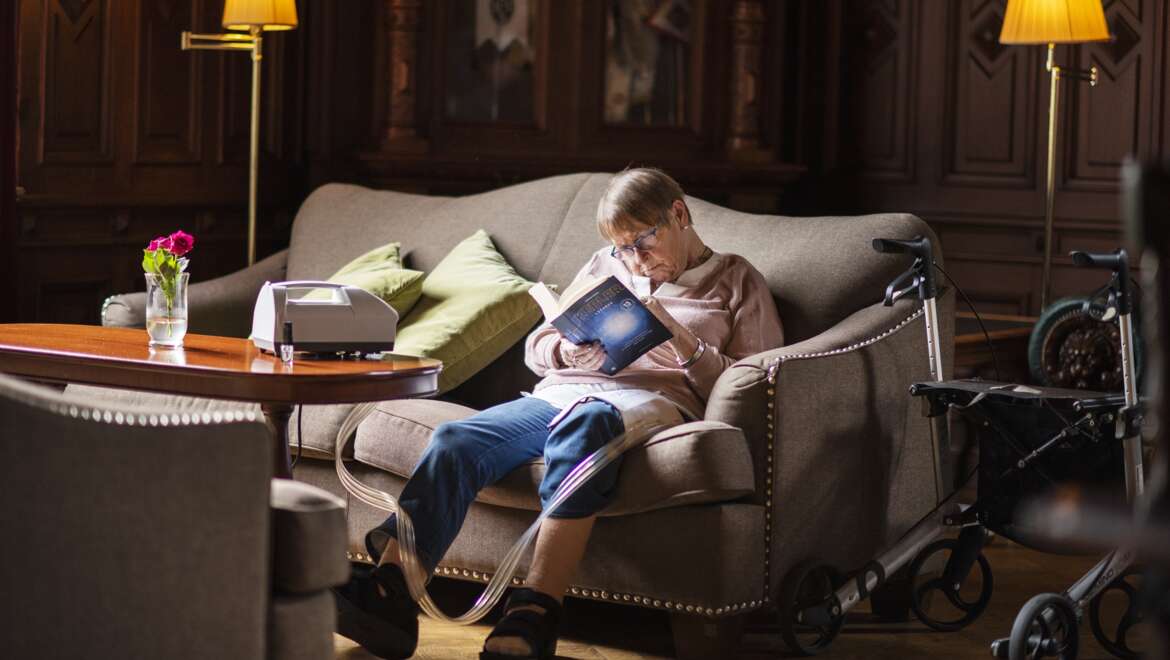
“I used to be very active, playing tennis and doing a lot of things. But all that disappeared when I got ill. I almost lost hope of getting better. I even feared that I would lose my legs,” says the 68-year old retired social administrator from the city of Helsingborg.
She continues: “All these years of suffering, frequent treatments and heavy medication forced me to retire early. It’s not easy to be focused and helpful when you are in a lot of pain. After the Arjo treatment, I am feeling more positive. If I can get rid of the ulcer on my other leg and use less bandage, I may even be able to drive my car again. That would be great.”
The VLU challenge
Venous leg ulcers are a rapidly growing problem all over the world. These treatment-intensive ‘hard-to-heal wounds’ cause pain and suffering for patients and high costs for healthcare providers.
VLU is a common and major medical problem especially among the elderly. Occasional minor bumps and bruises during daily activities for older people, who are typically less active and often have one or more health conditions, often become much more serious and require significant medical attention.
As we grow older, the skin breaks down and blood circulation in the legs is reduced. This results in pooling of blood in the damaged area, causing the leg to swell since the blood isn’t pumped back out of the leg.
The estimated global treatment cost for venous leg ulcers amounts to more than SEK 100 billion (approx. EUR 10 billion) per year. Research has shown that almost half (47%) of wounds do not heal within 12 months and that these account for about 80% of treatment costs1. Those affected can be exposed to several daily challenges such as pain and limited mobility2, which in some cases lead to depression, anxiety and social isolation.
Traditional VLU treatment
Traditionally, venous leg ulcers are treated with static compression to improve vein circulation in the affected leg and treat swelling. The downside of these firm compression bandages, which are designed to squeeze the leg and encourage blood to flow upwards towards the heart, is that they also apply pressure directly on the wound.
“My previous treatment methods were on top of the wounds. You can imagine how terribly painful that is,” Haide Nordh explains. “In addition to having to go to a clinic and change the bandages three times every week, I needed heavy medication to cope with the constant pain.”
WoundExpress – a revolution in wound therapy
The key to healing venous leg ulcers is to increase blood circulation in the leg. This enables oxygen- and nutrient-rich blood to reach the wound site. Also, since wounds can take months to heal, an ideal solution should be so easy to operate that it can be used in the patient’s home.
Arjo collaborated with the Welsh Wound Innovation Centre, Accelerate CIC and Helsingborgs Lasarett in Sweden, to develop and evaluate a revolutionary new therapy that addresses these needs. The result – WoundExpress – is a groundbreaking addition to Arjo’s solutions for enabling movement.
Unlike current methods, this IPC (Intermittent Pneumatic Compression) system features a cuff applied to the patient's thigh, away from the wound area. It is only used for two hours per day.
Emilia Löfström, Registered Nurse and Product Specialist at Arjo, has been following Haide Nordh’s case closely. Haide has also been part of a recent case study of WoundExpress involving ten leg ulcer patients at Helsingborgs Lasarett.
Emilia says: “WoundExpress features a specially-designed three-chamber garment, which attaches to a pump with a unique, patented timing cycle that augments venous and arterial blood flow. From a patient point of view, the do-it-yourself possibility has been very positive. The cuff location on the thigh is perceived as comfortable, which of course improves the willingness to go through the compression treatment as intended.”
She continues: “Improving or getting rid of these ulcers is not just about pain relief and needing less care. Leg ulcers can prevent people from doing so many things we take for granted. The patients have to plan their whole life around managing the pain and going to the clinic for changing dressings. Following the ten people in our case study, we have also seen how the improvements have made the patients in this group more positive and active.”
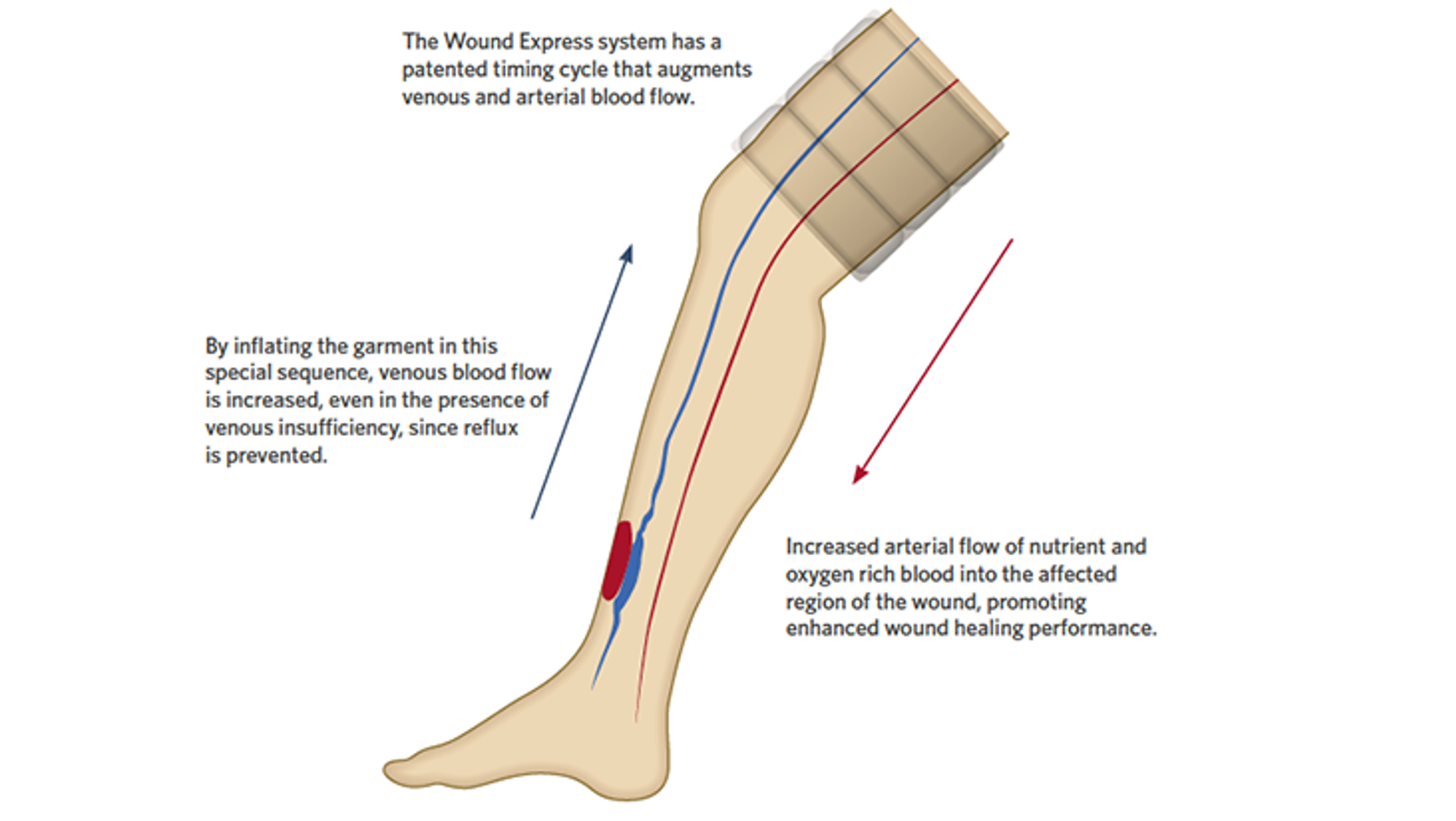
A study has demonstrated that applying sequential compression to the thigh alone can produce positive hemodynamic effects in the calves of patients with chronic wounds. Arterial blood flow velocity increased in the dorsalis pedis artery after periods of compression. Venous blood flow velocity increased when the lower chambers of the cuff deflated3.
By inflating the garment in this special sequence (illustration below), WoundExpress increases venous blood flow, even in the presence of venous insufficiency. The treatment also removes high levels of accumulated carbon dioxide and metabolic waste products from the wound site.
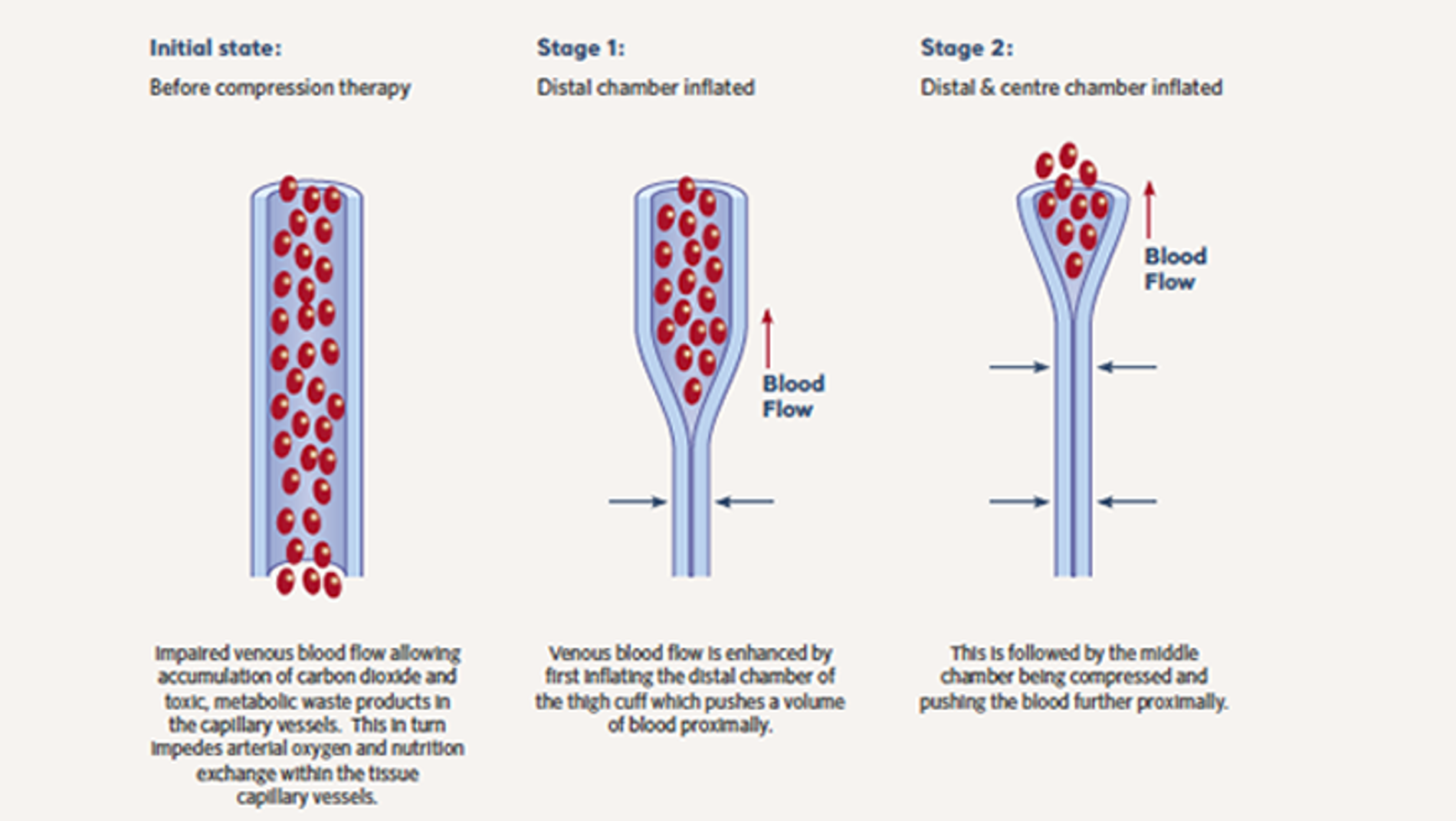
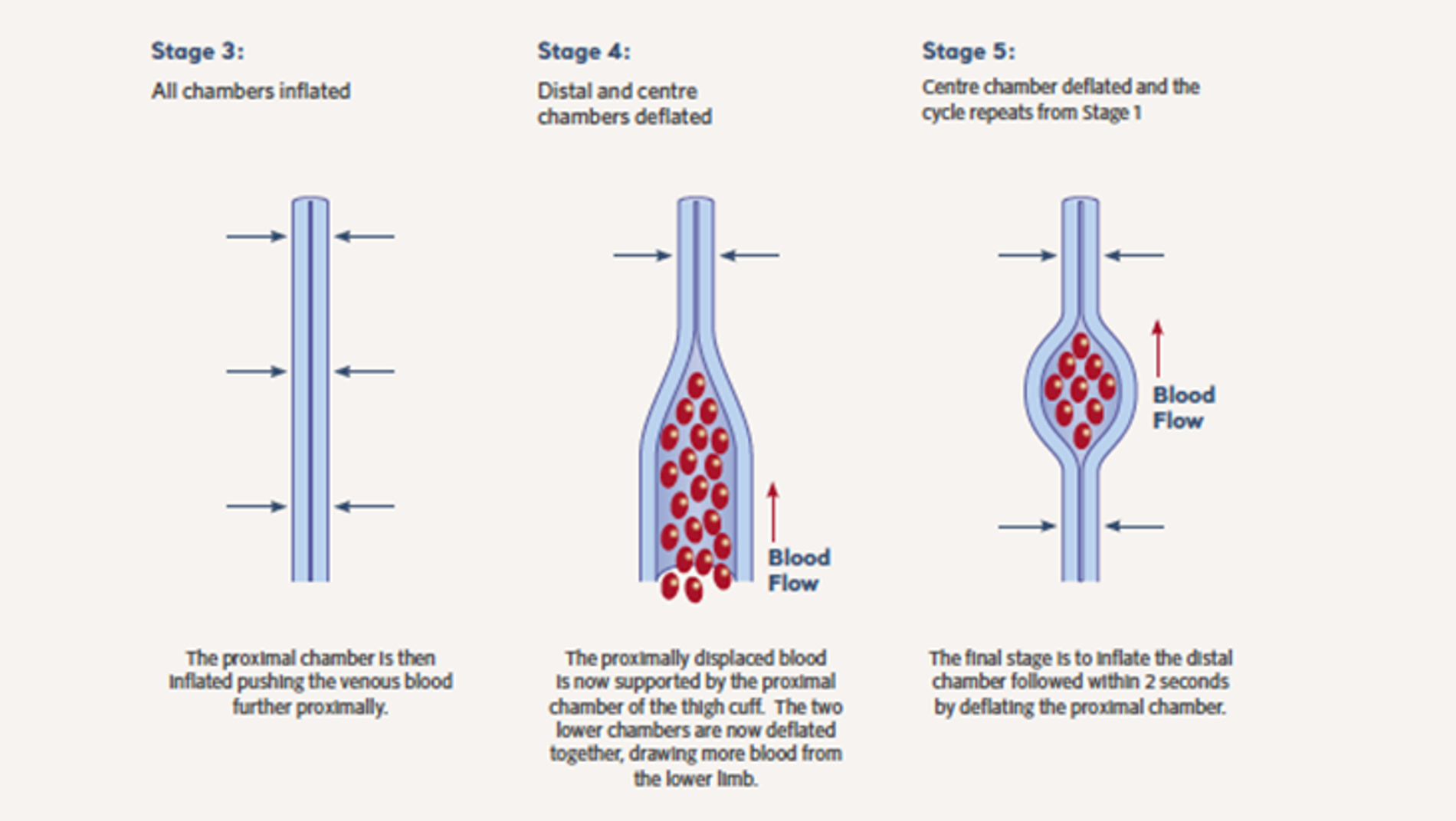
With its ease of use, WoundExpress is adapted for use at home, which can minimize disruption to daily activities and improve the patient's quality of life. The faster healing time can also lead to fewer dressing changes, which in turn frees up time for the care staff and reduces the costs for the care provider.
“The cuff and pump are easy to use, and I really appreciated that the cuff is placed around the thigh, with no direct pressure on the sensitive leg areas. It felt like a massage. I had my treatment in the summer, so doing the sessions in the cool evening hours while watching a good film or reading a book worked well for me,” Haide says.
She continues: “This has been a fantastic, almost magical experience. The wound on my heel was healed after four weeks, and the ulcer on the lower leg was all but gone after 16 weeks. After the treatment, I am more mobile than before, and I am feeling positive. If I can get rid of the ulcer on my other leg and use less bandage there too, I may even be able to drive my car again. That would be great.”
The clinical data
The revolution in advanced wound care therapy started by WoundExpress means that hard-to-heal wounds are now actually able to heal much faster, easier and more comfortably, improving the quality of life for thousands of people around the world every day.
In clinical evaluations of hard-to-heal ulcers, significant improvement was seen in wound healing, with a third of the cases healing entirely after only 16 weeks of treatment with WoundExpress. Furthermore, 80 per cent of patients reported significant reduction of ulcer-related pain. 4, 5
The case study of WoundExpress at Helsingborgs Lasarett, described earlier in this post, is included in a recent article published in Journal of Community Nursing (UK). It describes an evaluation of WoundExpress treatment on patients with hard-to-heal leg ulcers by eleven wound treatment centers or wound care specialists over a 16-week period in England, Wales and Sweden.6
53 participants completed the evaluations. 93 percent of their wounds progressed towards healing, with 33% healing completely and 60% progressing towards healing, with a mean surface area reduction.
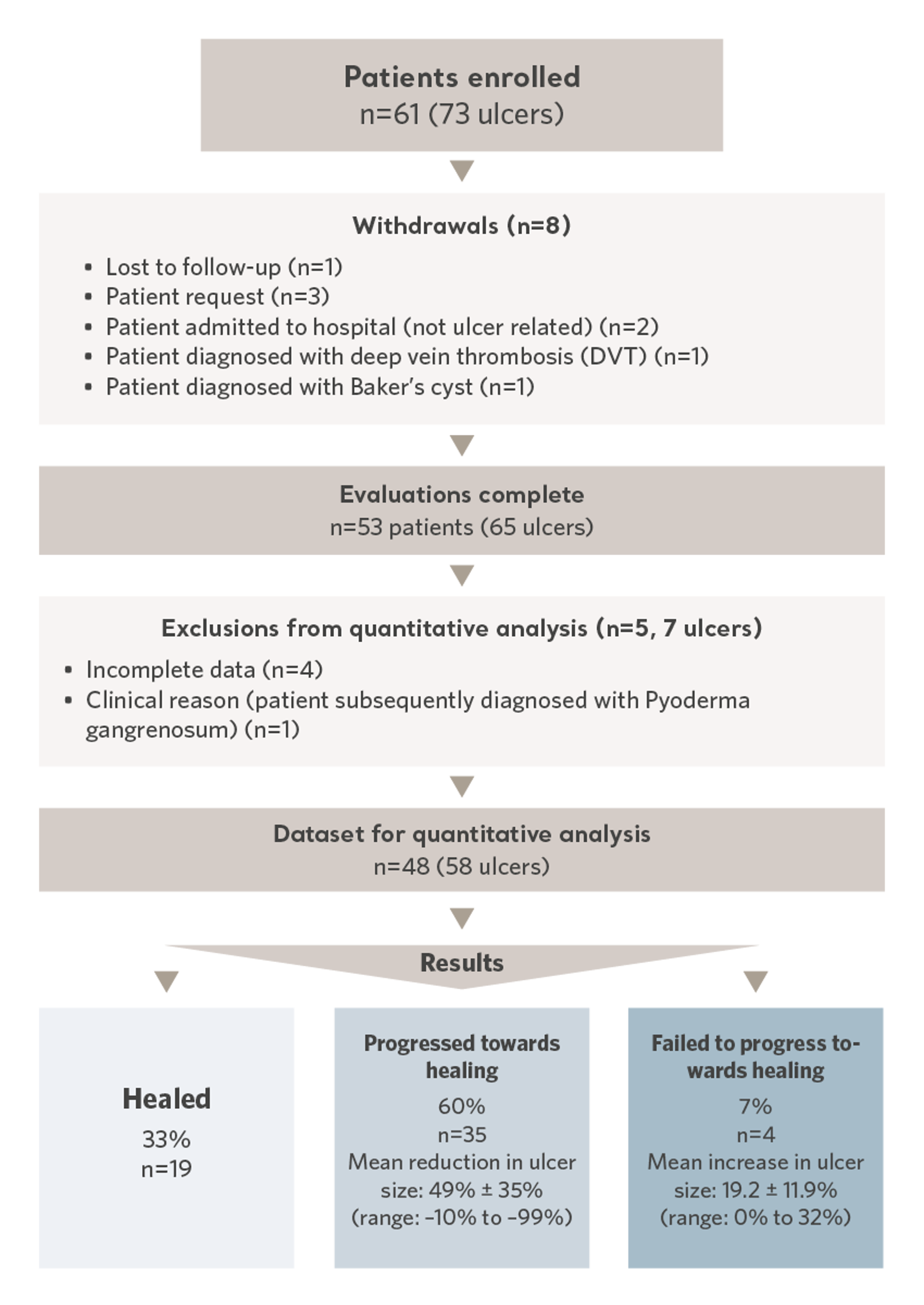
The authors conclude that since these wounds were considered ‘hard to heal’ with a mean duration of 50 months before inclusion in the study, it is reasonable to infer that achieving healing, or progression towards healing after the 16-week period was at least partly due to the addition of WoundExpress therapy to standard wound care.
The aim was to evaluate the effectiveness of IPC treatment applied to the thigh in chronic wounds of mixed or venous etiology. The wounds evaluated had an average duration of over 40 months and had not improved before starting treatment. During the test period, patients continued to undergo normal wound care.
The evaluation showed very promising results. Over 95% of the patients experienced a markedly improved healing of the wounds and in a third of the cases the wound healed completely. In addition, 95% of patients reported a significant reduction in pain and increased quality of life.
Keith Harding, Professor and Medical Director at the Welsh Wound Innovation Initiative, describes WoundExpress:
“It is an innovative and exciting new method of treating patients with lower leg ulcers. It may play a crucial role in the development of clinical practice. ”
Arjo has extensive experience of improving the clinical outcomes within, among other things, pressure ulcer and DVT solutions, a competence that contributes to developing solutions also for wound treatment. The launch of WoundExpress is a further step in ensuring that Arjo remains relevant to its customers and continues to help shape the healthcare of the future.
As a result of the improved outcomes in studies, Arjo aims to establish WoundExpress as a new standard treatment.
“With WoundExpress, we are expanding our already strong product portfolio, ensuring that we are at the forefront of solutions in wound care. Our goal is to continue to improve the clinical results and increase the care efficiency, which increases the value for both patients and care providers,” says Joacim Lindoff, President and CEO at Arjo.
For Haide Nordh, the treatment with WoundExpress has been a life-changing experience.
“After two weeks of treatment I went to the hospital for a dressing change. When I saw that the wounds had begun to heal, I was flying. It was a miracle. After all this time, something was finally happening. I am a new woman. As soon as the other leg is healed, Emilia and I will go dancing.”
Emilia concludes:
“Haide is a living proof of what we want to achieve with WoundExpress. In addition to healed ulcers, she is also happier, more energetic and active again. For me, that is Empowering Movement on all levels.”
References
1. Guest et al (2018)
2. Lernevall et al (2017)
3. Morris et al (2019)
4. Naik et al (2019)
5. Ivins N, Kettley K, Staines K, Turner-Dobbin H (2020)
6. Davies, Dunn (2021)